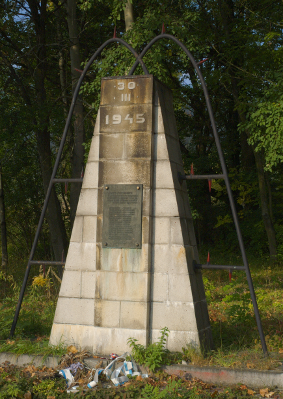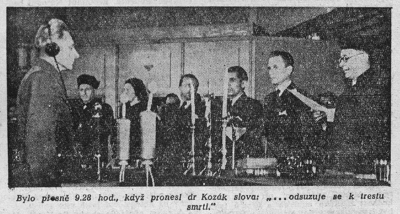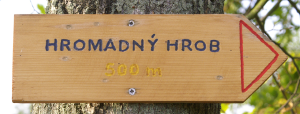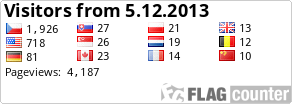 [CZ]
[CZ]
| |
 |
| |
Pomník vlastenců
|
Pojedete-li ze Šumperku směrem na Hanušovice, můžete si asi v polovině cesty do Bratrušova všimnout na pravé straně památníku. Pokud podlehnete zvědavosti, zastavíte a přijdete blíž, můžete si na pamětní desce přečíst:
VZDEJTE ČEST PAMÁTCE 16 SEVEROMORAVSKÝCH VLASTENCŮ, KTEŘÍ BYLI 31. BŘEZNA 1945 NA NÁSPU ZDEJŠÍ STŘELNICE ZÁKEŘNĚ ZAVRAŽDĚNI GESTAPEM
Deska obsahuje i jména zavražděných. Kdo ale byli? Co se tady na sklonku války, něco více než měsíc před osvobozením, stalo? A proč?
Tato keška si klade za cíl odpovědět alespoň na některé otázky a provést vás několik set metrů na vlastní dějiště tehdejší tragédie.
Nyní se však vraťme zpět do pohnutých dnů na přelomu září a října roku devatenáctistého třicátého osmého... Po zradě západních spojenců, kteří 29.9. podepisují mnichovskou dohodu, je ČSR hrubým nátlakem nucena odstoupit pohraniční oblasti s převahou německého obyvatelstva mezi 1. a 7. říjnem.
 |
|
|
Odstoupené pohraničí
|
|
Tzv. páté pásmo „převážně německého charakteru“ má být vymezeno mezinárodní komisí a předáno Německu do 10. října. Vytyčení je však určeno spíše ekonomickými a vojenskými aspekty a snahou proniknout co nejvíce do srdce Moravy. K říši jsou tak připojeny i obce s naprostou převahou českého obyvatelstva, např. český ostrůvek na Uničovsku (Šumvald, Troubelice, Pískov, Lazce, Lipinka) nebo české oblasti kolem Zábřeha. Mnozí Češi prchají do vnitrozemí, zejména státní zaměstnanci a jejich rodiny, lidé vázaní na půdu však často zůstávají.
Odbojová činnost kolem Troubelic začíná výrazněji sílit pod vlivem obratu na východní frontě, kdy je německá armáda poražena u Stalingradu. Je navázána spolupráce se sítí „Národního sdružení československých vlastenců“ se sídlem v Zábřehu. Během roku 1944 je však sdružení vážně oslabeno po prozrazení organizace a mnoho členů je zatčeno gestapem.
Po přejití nejhorší vlny zatýkání vzniká ještě v čtyřicátém čtvrtém roce odbojová skupina Troubelice-Pískov, která se po osvobození začne nazývat „Bradlo“. Skupina se zejména snaží získat zbraně a munici.
Mladí členové skupiny Miloš Vítek a bratři Kovářové se rozhodují obstarat si zbraně v autoopravně, kde je Vítek zaměstnán. Majitel – horlivý šumperský nacista Ernst Burischek – nahlásí ztrátu na gestapu. To nastraží léčku. V dílně 14. března 1945 odstaví auto s granáty a pancéřovými pěstmi. Hned ten večer je Vítek zatčen při pokusu odnést další zbraně a odveden do úřadovny gestapa naproti dnešnímu kinu Oko.
Po nelidském mučení nevydrží a prozrazuje jména dalších členů skupiny – během několika hodin je zatčeno dalších 5 lidí. Kolotoč bití a mučení ve sklepeních gestapa nabírá obrátky. Celkem je při zátahu 15.-23. března zatčeno celkem 18 lidí, z nichž jen dva jsou později propuštěni. Mají štěstí...
Ostatní jsou odvezeni do věznice gestapa v bývalé robotárně. O celé záležitosti je informován státní ministr pro Čechy a Moravu Karl Hermann Frank, který nařizuje popravu všech zatčených. Velitel šumperského gestapa Wilhelm Prellberg vybírá jako místo popravy bratrušovskou střelnici a nařizuje, aby zde byl v předvečer popravy – na Velký pátek 30. března – vykopán hromadný hrob.
Je brzké ráno 31. března... Bílá sobota... ještě je tma. Šestnáct zatčených vlastenců je vyvedeno z věznice a naloženo do nákladního auta. Vědí už, co je čeká na konci cesty?
Auto projíždí ztichlým Šumperkem a vyjíždí z města. Míří na Bratrušov. Po cestě zpomaluje a odbočuje doprava... na střelnici. Pozvolna jede do kopce a zastavuje v polovině střelnice.
Všichni vystupují a jsou spoutáni do dvojic. Kalným ránem kráčí k poslednímu stavu. Odtud je jen pět metrů k velké vykopané jámě. Teď už je vše jasné...
… je konec...
… konec všech snů, všech plánů, všech nadějí...
… domů ke svým milovaným se už nikdy nevrátí...
Po dvojicích jsou přivlečeni a musí si lehnout vedle sebe... do hrobu. Gestapáci Hufer a Tilg je popravují ranou do týla. Nikdo neprosí o milost, jen dva se tiše modlí...
To chladné svítání je strašné. I otrlý gestapák Hufer po popravě několika dvojic zkolabuje a úmyslně si poškodí zbraň. Popravu za něj dokončuje jeden z esesáckých poddůstojníků.
 |
|
Hromadný hrob
|
Oldřich Dušek, 20 let
Miroslav Jurka, 26 let
Bohumír Kovář, 31 let
František Kovář, 37 let
František Langer, 25 let
Rudolf Otevřel, 25 let
Jan Polák, 20 let
Jaromír Spurný, 21 let
Oldřich Spurný, 34 let
Arnošt Stryk, 23 let
Adolf Schwarzer, 29 let
Josef Utěšený ml., 18 let
Josef Utěšený st., 42 let
Jan Vítek, 26 let
Miloslav Vítek, 20 let
Antonín Vlček, 23 let
Pak gestapáci hrob zasypou a zamaskují drny a keříky. Velitel Prellberg zdůrazňuje, že popravení byli škůdci německého národa a upozorní, že pokud bude někdo mluvit, čeká ho stejný osud. Na gestapu se ten den slaví. Aby tu odpornou vraždu skryli, vystavují dokonce propouštěcí rozkazy na jména zavražděných. Příbuzným tvrdí, že jejich blízcí byli odvezeni k soudu do Berlína nebo do koncentračních táborů.
Za dalších 38 dní je Šumperk osvobozen Rudou armádou. Nikdo však neví, co se stalo s 16 zatčenými. Ta nejistota je hrozná... Zvrat v pátrání nastává poté, co Brunhilda Puschmannová, bývalá sekretářka gestapa a Prellbergova milenka poskytuje vyšetřovatelům informace a dokonce Prellbergovu fotografii.
Na rozeslaný fonogram přichází odpověď z Liberce – v místní věznici je zadržován jistý Hans Ulrich, který odpovídá popisu. Byl zatčen koncem května 1945 při pokusu o přechod československých hranic. V lednu 1946 se přiznává ke své totožnosti a po převozu do Šumperka označuje i místo popravy.
 |
|
|
Pohřeb zavražděných vlastenců
|
|
16.-18. ledna je provedena exhumace a soudní ohledání. Poté, 20. ledna, se koná národní pohřeb, jehož se účastní 20.000 lidí. Po dobu pohřbu je Němcům zakázáno vycházet do ulic. Po pietním aktu před šumperskou radnicí jsou rakve ve vojenském průvodu převezeny na nádraží, odkud jsou ostatky zavražděných odvezeny do domovských obcí (oběti z Troubelic a Pískova na hřbitov u farního kostela do Hradečné, oběti z Králové ke kostelu v Medlově).
 |
|
|
K. H. Frank při vynesení rozsudku
|
|
A jak dopadli vrazi?
K. H. Frank, který vydal rozkaz k popravě, prchá 9. května 1945 k americkým liniím. V Rokycanech je americkými vojáky zatčen a dopraven do Wiesbadenu. Následně je předán československé justici, odsouzen Mimořádným lidovým soudem v Praze k trestu smrti (mj. i za vypálení Lidic a Ležáků) a 22. května 1946 oběšen na dvoře Pankrácké věznice před zraky 5.000 diváků.
Velitel šumperského gestapa Wilhelm Prellberg byl odsouzen lidovým soudem k trestu smrti a 13. listopadu 1946 v Olomouci oběšen. V následujícím roce dostávají provaz i kati Hufer a Tilg.
| |
 |
| |
Směrovka
|
9. května 1965 byl slavnostně odhalen pomník podle návrhu ing. Ladislava Doubravského – zde začne vaše putování. V roce 1996 byla přidána pamětní deska a konečně v roce 2013 skupina nadšenců, která si říká Pátrači, vyznačila směrovkami místo hrobu a pietně jej upravila.
Pokud vás tato keška přiměje alespoň na chvíli se zamyslet nad cenou svobody a vzdát v duchu hold těmto 16 hrdinům, pak splnila svůj účel.
A nyní se již můžete vydat za keškou... pamatujte, že kráčíte stejnými místy jako před více než 65 lety oběti a jejich vrazi.
- N 49° 59.312 E 016° 57.803 Spočítejte, kolik nejvíce popravených pocházelo z jedné obce (A).
- N 49° 59.312 E 016° 57.803 Na pomníku naleznete dvě lehce odlišná data. B je číslice v označení dne, která je stejná.
- N 49° 59.369 E 016° 57.878 Stojíte na břehu malého rybníčku. Naproti vám je na břehu smrk (F=9), vrba (F=7), bříza (F=5) nebo javor (F=3).
- N 49° 59.411 E 016° 57.928 Cestička zde překonává terénní nerovnost několika schody. C je polovina z počtu schodů.
- N 49° 59.546 E 016° 57.955 Mezi vámi a cestičkou, po které jste přišli, jsou čtvery betonové schody. Jedny schody mají jiný počet (E) stupňů než ostatní.
- N 49° 59.574 E 016° 57.982 Stojíte u hromadného hrobu, před vámi je pamětní deska. Počet písmen ve druhém slovu na posledním řádku je D.
Finální souřadnice jsou N 49° 59.ABC E 016° 57.DEF. Keš obsahuje kromě logbooku, tužky a ořezávátka i nějaké drobnosti na výměnu a CWG pro první tři nálezce bez výměny, další 2 CWG na výměnu.
Literární zdroje:
Spurný František: Bratrušovská tragédie. 1970. Vlastivědné zajímavosti č. 9
Bartoš Josef: Český ostrůvek na Uničovsku v okupovaném pohraničí. 2.10.2002. Britské listy
Měsíčník obce Troubelice, 8/2005
Hanušovické noviny, 6/2010
Dolnostudénský zpravodaj, 2/2013
 [EN]
[EN]
| |
 |
| |
The Patriots Memorial
|
When driving from Šumperk to Hanušovice you may notice a memorial on the right hand side, about half way to Bratrušov. If you are curious enough to stop and come closer, you can see a memorial plaque quoting:
HONOR THE MEMORY OF 16 NORTHMORAVIAN PATRIOTS WHO WERE BRUTALLY MURDERED BY THE GESTAPO ON AN EMBANKMENT OF THE LOCAL SHOOTING RANGE ON 31 MARCH 1945
The plaque also includes names of murdered ones. Who were they? What had happened here at the end of the war, more than a month before the liberation? And why?
The purpose of this cache is to answer at least some of the questions and walk you few hundred meters around the scene of the tragedy itself.
Let's go back now to eventful days at the end of September and beginning of October 1938...After the betrayal when the Western Allies signed the Munich Agreement on 29 September, Czechoslovakia was forced to withdraw from border areas with majority of German population between 1st and 7th October.
 |
|
|
Border regions after withdrawal
|
|
The so-called fifth zone of “mainly German character” should have been defined by the International Commission and handed over to Germany by 10 October. However, demarcation was determined by rather economic and military aspects as well as efforts to penetrate the heart of Moravia as far as possible. Villages with vast majority of Czech population were therefore annexed to the Reich as well, such as the Czech isle in the Uničov region (Šumvald, Troubelice, Pískov, Lazce, Lipinka) or Czech areas around Zábřeh. Many Czechs fled inland, especially government employees and their families, however, people tied to their land often remained.
Resistance activities grew significantly stronger influenced by turnover on the Eastern Front, where the German army was defeated at Stalingrad. Cooperation with "the National Association of Czechoslovak patriots" in Zábřeh was established. During 1944, the association was, however, seriously weakened after the organization was revealed and many of its members were arrested by the Gestapo.
After the worst wave of arrests was over, a new resistance group Troubelice-Pískov was formed in 1944. It was called „Bradlo“ after the liberation. In particular, the group tried to acquire weapons and ammunition.
Young members of the group Miloš Vítek and the Kovář brothers decided to get weapons at a repair shop where Vítek worked. The owner Ernst Burischek – enthusiastic Šumperk Nazi – reported the loss to the Gestapo. They set off a trap and brought a car with grenades and panzerfausts over to the repair shop. Vítek was immediately arrested that night for stealing another weapons and he was taken to the Gestapo office across the street from today’s cinema “Oko”.
After horrific torture he gave in and revealed names of other members of the group –another five people were arrested in just a few hours. Pressure of beating and torturing in Gestapo dungeons grew stronger. Total of 18 people were arrested in the attack of 15-23 March, two of them were later released. They were lucky...
The others were taken to the Gestapo prison at the former manufacturing plant. Karel Hermann Frank, Ministry of State for Bohemia and Moravia, got informed about the whole matter and ordered that all the arrested were to be executed. Wilhelm Prellberg, chief of the Šumperk Gestapo, chose the Bratrušov shooting range as a place of execution and ordered to dig a mass grave there in the evening before the execution – on Good Friday 30 March.
It is early in the morning 31 March... Holy Saturday... it is still dark. Sixteen arrested patriots are taken out of the prison and loaded into a truck. Do they know yet what is going to happen at the end of the road?
The car is passing through quiet Šumperk. It is leaving the town and heading to Bratrušov. It slows down on the way and turns right...to the shooting range. It is slowly going up the hill an stops in the middle of the shooting range.
Everyone gets out of the car and is handcuffed in pairs. They walk to the last place in the dull morning. It is only five meters from here to the dug hole. Everything is clear now...
… it is the end...
… end of all dreams, all plans, all hopes...
… they will never return home to their loved ones...
They are dragged in pairs and they have to lie down next to each other...in the grave. The gestapo men Hufer and Tilg executed them by shooting in the back of their heads. Nobody begs for mercy, two of them are quietly praying...
That cold dawn is horrible. Even a tough Gestapo man Hufer collapsed after execution of several pairs and intentionally damaged his gun. One of the SS non-commissioned officers finished the execution for him.
 |
|
Mass grave
|
Oldřich Dušek, 20 years
Miroslav Jurka, 26 years
Bohumír Kovář, 31 years
František Kovář, 37 years
František Langer, 25 years
Rudolf Otevřel, 25 years
Jan Polák, 20 years
Jaromír Spurný, 21 years
Oldřich Spurný, 34 years
Arnošt Stryk, 23 years
Adolf Schwarzer, 29 years
Josef Utěšený Jr., 18 years
Josef Utěšený Sr., 42 years
Jan Vítek, 26 years
Miloslav Vítek, 20 years
Antonín Vlček, 23 years
The Gestapo then filled up the grave and covered it with pieces of turf and small bushes. Commander Prellberg stressed that the executed were saboteurs of the German people and he warned about the same fate for those who speak up. The Gestapo was celebrating that day. To hide the horrible murder they even issued release orders with names of the murdered ones. They told to relatives that their loved ones were taken to a court in Berlin or to concentration camps.
Šumperk was liberated by the Red Army 38 days later. Nobody knew, however, what had happened to the 16 arrested. Uncertainty was unbearable...Turning point of the investigation came after Brunhilda Puschmann, former secretary of the Gestapo and Prellberg's mistress, provided investigators with information and even with a Prellberg's photography.
A phonogram reply came from Liberec – some Hans Ulrich was being held at a local prison and he matched the description. He was arrested at the end of May 1945 while trying to cross the Czechoslovak borders. He confessed his identity in January 1946 and he had marked the location of the execution after he was transported to Šumperk.
 |
|
|
Funeral of murdered patriots
|
|
Exhumation and forensic examination was carried out between 16 and 18 January. On 20 January, a national funeral was held and it was attended by 20.000 people. Germans were forbidden from walking in the streets during the funeral. After the memorial ceremony, coffins were paraded by a military personnel to the station, where remains of the murdered were transported to their home towns (victims from Troubelice and Pískov to a parish church cemetery in Hradečná, victims from Králové to Mendlov).
 |
|
|
K. H. Frank at the verdict announcement
|
|
How did the killers end up?
K. H. Frank, who ordered the execution, fled towards the American lines on 9 May 1945. He got arrested by the U.S. soldiers in Rokycany and he was taken to Wiesbaden. After that he was handed over to the Czechoslovak justice, sentenced to death penalty by the People's Court in Prague (as well as for burning out Lidice and Ležáky) and he was hanged in the Pankrác prison yard in front of 5,000 spectators.
Wilhelm Prellberg was sentenced to death by the People's Court and hanged in Olomouc on 13 November 1946. Executioners Hufer and Tilg were hanged the following year.
The memorial, designed by Ing. Ladislav Doubravský, was officially unveiled On 9 May 1945. Here your journey begins. The memorial plaque was added in 1996 and in 2013 a group of enthusiasts who called themselves the Searchers finally marked out the grave with guideposts and adjusted it respectfully.
If this cache makes you think for a moment to value freedom and honour these 16 heroes, then it has served its purpose.
And now you can set off for the cache...remember you are walking in the same place as victims and their murderers more than 65 years ago.
- N 49° 59.312 E 016° 57.803 Count the highest number of the executed ones from the same town (A).
- N 49° 59.312 E 016° 57.803 You will find slightly different data on the memorial. B is the digid of the day that is the same
- N 49° 59.369 E 016° 57.878 You are standing by a small pond. On the opposite shore is spruce ( F=9), willow (F=7), birch (F=5) or maple (F=3).
- N 49° 59.411 E 016° 57.928 Here the path levels uneven terrain with a few steps. C is half of the number of steps.
- N 49° 59.546 E 016° 57.955 There are four concrete stairs between you and the path. One stair has different number ( E) of steps than the others.
- N 49° 59.574 E 016° 57.982 You are standing at the mass grave with the memorial plaque in front of you. Number of letters in the second word on the last line is D.
Final coordinates are N 49° 59.ABC E 016° 57.DEF. Apart from a logbook, pencil and a pencil sharpener this cache also contains some trinkets for trading and a CWG for the first three finders without trading and another two CWG for trading.
Literature:
Spurný František: Bratrušovská tragédie. 1970. Vlastivědné zajímavosti č. 9
Bartoš Josef: Český ostrůvek na Uničovsku v okupovaném pohraničí. 2.10.2002. Britské listy
Měsíčník obce Troubelice, 8/2005
Hanušovické noviny, 6/2010
Dolnostudénský zpravodaj, 2/2013
